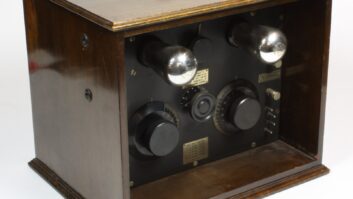Jell-O, Lucky Strike, Ford and Pepsodent are national brand names that were built primarily on early radio. So were most of Procter & Gamble’s biggest products.
Does It Work?Asked by Radio World for examples of the effectiveness of its initiative, Clear Channel offered these.
Doug McAllister, general sales manager of WMJJ(FM)/WQEN(FM) in Birmingham, Ala., wrote Cook to say that a mortgage company that ran a series of two-voice 30-second spots was happy with the results. This client sent an unsolicited letter to the station thanking Tenille Smith, senior account executive, by name.
Barbara Scott Sherry, commercial production director for Clear Channel in Atlanta, reported that she used the Creative Work Plan to educate her client, ERA Sunrise Realty, as to the best ways to use radio. Then the station created a 30-second spot called “Protecting Your Dream,” the first in a series.
“In the commercials we use the station Web site and keyword as a contact rather than phone numbers no one remembers,” Scott Sherry said.
The Dayton cluster wanted to get a reluctant car dealer on the air. This client didn’t want to be perceived as a “sleazy, plaid jacket-firm handshake” store, so the station grabbed the “Business People” spec campaign from the Clear Channel Web site. Production director Jim Hausfeld was able to put the commercial together in less than an hour and reported that the client loved it.
“This opened a door which was firmly shut before,” said Hausfeld. “He still hasn’t bought, but is excited about finding a way to get the creative on the air.”
But since the waning of network entertainment programs in the 1950s and the expansion of local market advertisers such as car dealers, furniture stores and malls, radio has had a more difficult time creating effective commercials. Too often this task is handed to an untrained continuity person or a salesperson busy with other duties.
While national radio ads usually are professionally produced by agencies, many local spots are poorly thought out and rushed through production, yielding less than wonderful results. Or so goes the logic behind a recent venture at Clear Channel.
Starting with seminars
Last summer John Hogan, Clear Channel Radio CEO, launched the widely reported initiative “Less Is More,” under which stations would begin playing fewer and shorter commercials.
Then in October, the broadcaster announced the formation of a Creative Resource Group, which it describes as part of its effort to improve radio’s quality for listeners and its value for advertisers.
The new group’s mission is to act as “a resource to advertising agencies and local stations, assisting them in creating engaging and memorable radio ads, offering creative coaching, online toolkits and ongoing direction in the creation, writing and production of compelling ad spots.”
In the announcement, Clear Channel said the group also would conduct training of station staff to ensure that sales and creative employees “are indispensable resources in the quest for more compelling content.” Clear Channel says its creative effort is unprecedented.
The company appointed three executives to help lead the initiative. Programmer Bob Case was promoted to managing director; Robert Summers was hired as a managing director; and producer Yaman Coskun joined as creative coordinator and senior producer. The creative group was also charged with playing a role in aiding the transition to more 30-second spots. It has seven employees total.
“John asked me to put together a group of people that could fill in the hard part of this task,” said Jim Cook, Clear Channel senior vice president of creative services. “That meant taking the commercials that were left and making them better.”
“Selling with Sound” was born.
Cook hired several radio ad “gurus” as consultants to help. They include Jack Trout, who in 1981 began to write about a new concept known as “positioning.” The self-proclaimed Wizard of Ads, Texan Roy H. Williams, was added to the lineup; and Dick Orkin, head honcho of the Famous Radio Ranch, came onboard.
The group put together a series of seminars starting in Los Angeles, then Atlanta, New York and Chicago.
“Attendance is by invitation only; about 40 percent is drawn from our sales force, 40 percent from our programming/production departments, 10 percent are guests including ad agencies and the rest come from the press and other groups,” said Cook.
“It’s an intense day-and-a-half that begins at 8 a.m. with a talk from John Hogan, myself, then Orkin, Robert Summers, our creative director for the Creative Services Group, then former agency writer Terry Yormark followed by Bob Case, managing director of the Creative Services Group.
“At the end of the seminar we send all our people to breakout meetings with their regional senior vice presidents. We provide them with materials and online resources to work with,” he said.
Attendees are given turnkey spec spots, ad copy written for specific categories, as well as video and audio, which is available on the Clear Channel intranet. They are asked to report back to management with local success stories.
“As human beings, the first sense we develop is hearing,” Cook said. “We make emotional connections with sound. Too many radio commercials have become announcements lacking an emotional center.”
Focus on the customer
Alex Kolobielski is president of First Media, a broadcast group based in Easton, Md., which owns a number of small-market stations.
“Clear Channel is correct,” he said. “As an industry we have to put more focus on the customer and the ads themselves. Sales reps who are continuously updating client copy, writing and producing creative ads and thinking up new ways to use our medium for our customers are in good shape, and their clients are in good shape. Unfortunately that’s less than half of all reps in the country.”
He said radio doesn’t need the same copy that was written 10 years ago.
“We need fresh ideas; and a $15,000 per year continuity person can only write a piece of copy like a $15,000 per year convenience store employee.”












